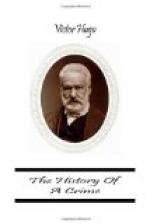“The whole of this quarter is barricaded; and if, as I hope, our friends come down, I will answer that they will hold it for a long time.”
Suddenly he stopped. “Here is one,” said he. In truth, seven or eight paces before us was a barricade entirely constructed of paving-stones, not exceeding a man’s height, and which in the darkness appeared like a ruined wall. A narrow passage had been formed at one end. We passed through it. There was no one behind the barricade.
“There has already been fighting here a short time ago,” said the last-maker in a low voice; and he added, after a pause, “We are getting near.”
The unpaving had left holes, of which we had to be careful. We strode, and sometimes jumped, from paving-stone to paving-stone. Notwithstanding the intense darkness, there yet hovered about an indefinable glimmer; on our way we noticed before us on the ground, close to the foot-pavement, something which looked like a stretched-out form. “The devil!” muttered my guide, “we were just going to walk upon it.” He took a little wax match from his pocket and struck it on his sleeve; the flame flashed out. The light fell upon a pallid face, which looked at us with fixed eyes. It was a corpse lying there; it was an old man. The last-maker rapidly waved the match from his head to his feet. The dead man was almost in the attitude of a crucified man; his two arms were stretched out; his white hair, red at the ends, was soaking in the mud; a pool of blood was beneath him; a large blackish patch on his waistcoat marked the place where the ball had pierced his breast; one of his braces was undone; he had thick laced boots on his feet. The last-maker lifted up one of his arms, and said, “His collar-bone is broken.” The movement shook the head, and the open mouth turned towards us as though about to speak to us. I gazed at this vision; I almost listened. Suddenly it disappeared.
This face re-entered the gloom; the match had just gone out.
We went away in silence. After walking about twenty paces, the last-maker, as though talking to himself, said in a whisper, “Don’t know him.”
We still pushed forward. From the cellars to the roofs, from the ground-floors to the garrets, there was not a light in the house. We appeared to be groping in an immense tomb.




